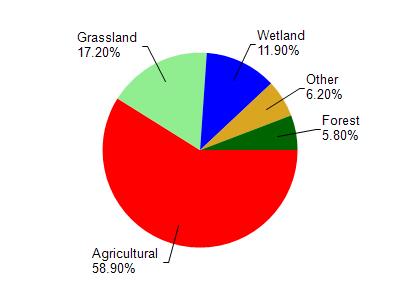Dodge
No
No
No
Fish and Aquatic Life
Overview
This damsite was regarded as the finest for water power production on the Rock River above Rock Island, Illinois, and the original dam and sawmill were constructed in 1845-46. Bullheads, northern pike and crappies provide fishing although carp are the most abundant species present. Winterkills have occurred, caused by both municipal and industrial sources of pollution. Bottom materials vary from silt to sand and gravel. A boat launching ramp provides access along with a four-acre city park which affords over 700 feet of frontage along the east shore.
Surface Acres = 19 acres, S.D.F. = 3.11, Maximum Depth = 8 feet
Source: 1965, Surface Water Resources of Dodge County Mayville Millpond, Upper T12N, R16E, S23
Date 1965
Author Aquatic Biologist
Condition
Wisconsin has over 84,000 miles of streams, 15,000 lakes and milllions of acres of wetlands. Assessing the condition of this vast amount of water is challenging. The state's water monitoring program uses a media-based, cross-program approach to analyze water condition. An updated monitoring strategy (2015-2020) is now available. Compliance with Clean Water Act fishable, swimmable standards are located in the Executive Summary of Water Condition in 2018. See also the 'monitoring and projects' tab.
Recommendations
Shoreland Ordinance
Dodge County Planning & Development Department is interested in revising the Dodge County Shoreland Zoning Regulations and adopting a "waterway" classification system to better regulate and manage the county's water resources.
Management Goals
Wisconsin's Water Quality Standards provide qualitative and quantitative goals for waters that are protective of Fishable, Swimmable conditions [Learn more]. Waters that do not meet water quality standards are considered impaired and restoration actions are planned and carried out until the water is once again fishable and swimmable
Management goals can include creation or implementation of a Total Maximum Daily Load analysis, a Nine Key Element Plan, or other restoration work, education and outreach and more. If specific recommendations exist for this water, they will be displayed below online.
Monitoring
Monitoring the condition of a river, stream, or lake includes gathering physical, chemical, biological, and habitat data. Comprehensive studies often gather all these parameters in great detail, while lighter assessment events will involve sampling physical, chemical and biological data such as macroinvertebrates. Aquatic macroinvertebrates and fish communities integrate watershed or catchment condition, providing great insight into overall ecosystem health. Chemical and habitat parameters tell researchers more about human induced problems including contaminated runoff, point source dischargers, or habitat issues that foster or limit the potential of aquatic communities to thrive in a given area. Wisconsin's Water Monitoring Strategy was recenty updated.
Grants and Management Projects
Monitoring Projects
| WBIC | Official Waterbody Name | Station ID | Station Name | Earliest Fieldwork Date | Latest Fieldwork Date | View Station | View Data |
|---|
| 862400 | Upper Mayville Millpond 172 | 10001259 | Rock River East Branch - E Brnch Rock R 10 Up Mayvl Mlpd | 7/1/2010 | 9/22/2017 | Map | Data |
| 862400 | Upper Mayville Millpond 172 | 10017824 | Rock River-East Branch -- Access | 8/2/2012 | 10/17/2023 | Map | Data |
| 862400 | Upper Mayville Millpond 172 | 10019505 | Rock River - East Fork -- Village Park 2 | 6/5/2012 | 9/30/2013 | Map | Data |
|

Watershed Characteristics
Upper Mayville Millpond 172 is located in the East Branch Rock River watershed which is 198.99 mi². Land use in the watershed is primarily agricultural (58.90%), grassland (17.20%) and a mix of wetland (11.90%) and other uses (12.00%). This watershed has 306.48 stream miles, 292.02 lake acres and 16,059.62 wetland acres.
Nonpoint Source Characteristics
This watershed is ranked High for runoff impacts on streams, High for runoff impacts on lakes and High for runoff impacts on groundwater and therefore has an overall rank of High. This value can be used in ranking the watershed or individual waterbodies for grant funding under state and county programs.However, all waters are affected by diffuse pollutant sources regardless of initial water quality. Applications for specific runoff projects under state or county grant programs may be pursued. For more information, go to surface water program grants.